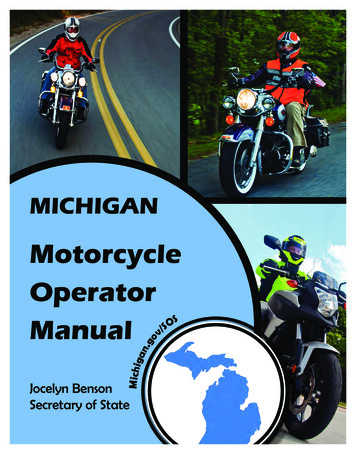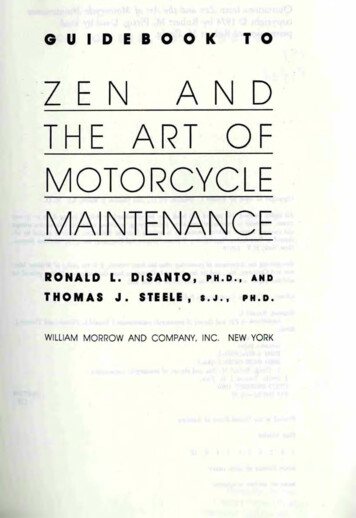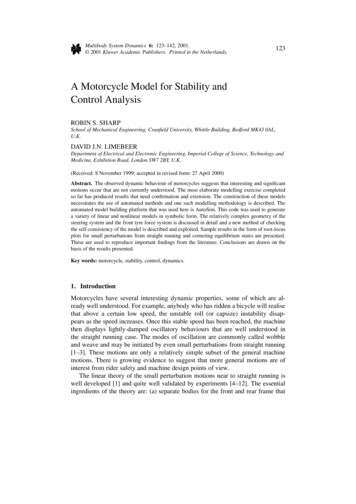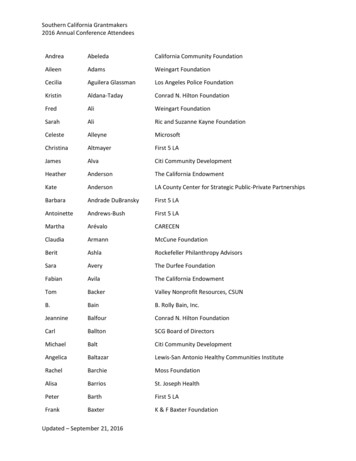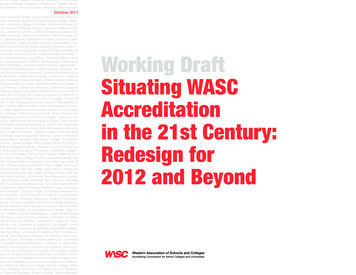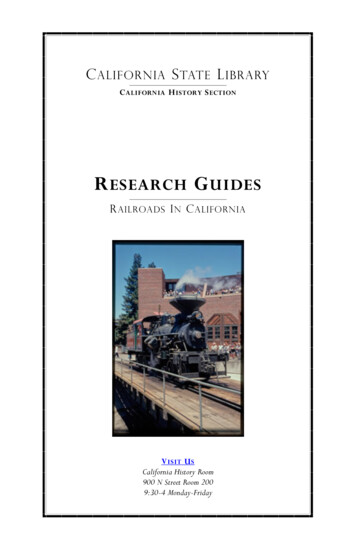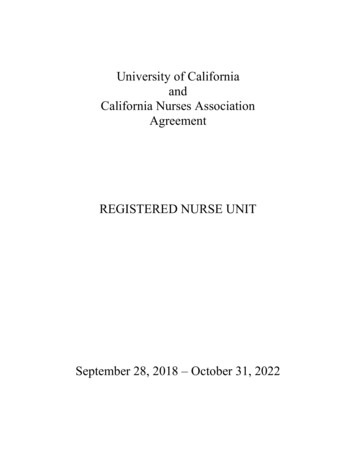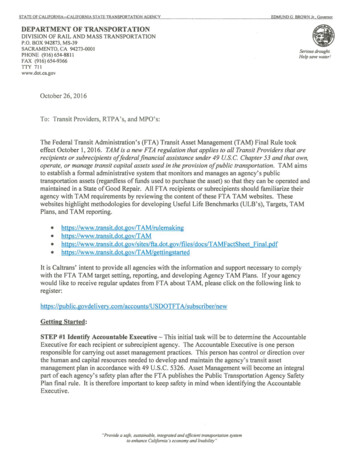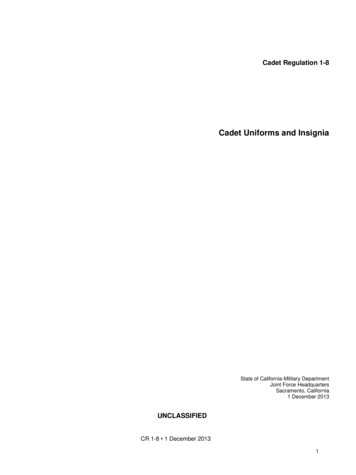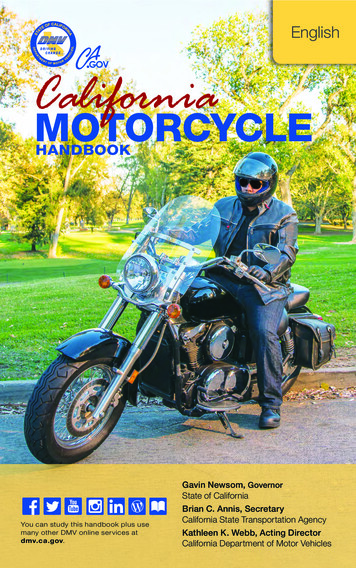
Transcription
EnglishMOTORCYCLEHANDBOOKGavin Newsom, GovernorState of CaliforniaYou can study this handbook plus usemany other DMV online services atdmv.ca.gov.Brian C. Annis, SecretaryCalifornia State Transportation AgencyKathleen K. Webb, Acting DirectorCalifornia Department of Motor Vehicles
Do You Need a REAL IDDriver License or ID Card?DRIVER LICENSEThe California DMV offers federal compliant REAL ID driver licenseand identifcation (ID) cards.A REAL ID or another federal compliant document will be requiredto board a domestic fight or enter a federal facility or military basestarting October 1, 2020.All valid California driver license and ID cards can be used to boarddomestic fights until October 1, 2020.REALIDGTo apply for a REAL ID card: Make an appointment to visit a DMV feld offce(appointment strongly recommended). Visit the DMV website for a list of documents needed to apply.Those under 18 years old are not required to have a REAL ID to fly. Visitorsshould contact federal facilities or military bases before visiting to determinewhat identification will be accepted.More information available at REALID.dmv.ca.gov.
TABLE OF CONTENTSNEW LAWS 2016.iiDISCLAIMER.iiWHERE TO WRITE .iiDMV INFORMATION .iiiINTRODUCTION.1TWO-WHEEL VEHICLE OPERATION .1Being Followed . 19Passing and Being Passed . 19Passing. 19Being Passed . 19Lane Splitting. 20Merging Vehicles . 20Vehicles Alongside . 20Search, Evaluate, andExecute (SEE). 21Search . 21Evaluate . 21Execute. 22Intersections. 22Blind Intersections. 23Passing Parked Vehicles . 23Parking at the Roadside . 26Increasing Visibility. 26Clothing . 27Headlight . 27Turn Signals . 27Brake Light . 28Using Your Mirrors . 28Head Checks. 29Horn. 29Riding at Night . 29Collision Avoidance . 30Quick Stops. 30Swerving or Turning Quickly . 31Cornering. 32Handling Dangerous Surfaces . 33Uneven Surfaces and Obstacles .33Slippery Surfaces. 34Railroad or Trolley Tracks andPavement Seams . 35Grooves and Gratings . 35Mechanical Problems . 36Tire Failure . 36Stuck Throttle . 36Wobble . 36Chain Problems . 37Engine Seizure . 37Animals. 37Flying Objects. 38Getting Off the Road . 38Carrying Passengers and Cargo . 38Equipment . 38Motorcycles Towing Trailers . 39Instructing Passengers. 39Riding With Passengers . 39Child Passengers . 40Carrying Loads . 40Motorcycles . 1Motor-Driven Cycles . 2Motorized Bicycles or Moped . 2Electric Bicycles . 2Motorized Scooter . 2LICENSE REQUIREMENTS .3Earning Your License . 3Motorcycle Type-License ClassChart . 4Requirements for a Motorcycle M1 orM2 License. 5California Motorcyclist SafetyProgram Training Course . 6Cheating. 6Motorcycle Skills Test . 6PREPARING TO RIDE .8Wear the Right Gear . 8Helmet Use. 8Helmet Selection . 9Face, Eye, and Ear Protection. 9Clothing . 10Know Your Motorcycle . 11The Right Motorcycle . 11Get Familiar With the MotorcycleControls . 11Check Your Motorcycle . 12Know Your Responsibilities . 13RIDE WITHIN YOUR ABILITIES . 14Basic Vehicle Control . 14Body Position . 14Shifting Gears. 14Braking . 15Turning . 15U-turns. 16Keeping Your Distance . 16Lane Positions . 16Carpool/High-Occupancy Vehicle(HOV) Lanes . 17Toll Highways and VehicleCrossings: Using Transponders orElectronic Payment Devices. 17Following Another Vehicle . 18-i-
Group Riding . 41Keep the Group Small . 41Keep the Group Together . 41Keep Your Distance . 42BEING IN SHAPE TO RIDE . 43Blood Alcohol Concentration . 43GET A DUI – LOSE YOUR LICENSE! . 44Alcohol and the Law. 45Minimize the Risks . 45Fatigue . 45MOTORCYCLE INSURANCE FACTS. 46EVADING A PEACE OFFICER . 46TREAD LIGHTLY! . 47KNOWLEDGE TEST SAMPLE 1 . 49KNOWLEDGE TEST SAMPLE 2 . 51NEW LAWS 2016Effective January 1, 2016Electric Bicycle ClassesThree classes of electric bicycles have been created. All operators of a Class 3 (maximumspeed of 28 miles per hour [mph]) electric bicycle must be 16 years old or older and arerequired to wear a bicycle helmet. There is no financial responsibility, driver license (DL),registration, or license plate requirement for these electric bicycles. More information onelectric bicycles can be found in the California Vehicle Code (CVC) §§312.5, 12804.9,21113, & 24016 and in this handbook.Effective January 1, 2017Increased Accident Reportability ThresholdThe minimum damage threshold for collision reportability will increase from 750 to 1,000. A driver of a motor vehicle involved in a collision with property damages greaterthan 1,000 must submit a Report of Traffic Accident Occurring in California (SR 1) toDMV. DMV is authorized to impose sanctions following an uninsured reportable collision(CVC §§1656.2, 1808, 1808.1, 12517.1, 13369, 13558, 16000, 16000.1, 16020.1, 16020.2,16075, 16251, 16430, & 16434).DisclaimerThis handbook is only a summary of laws and regulations. DMV, law enforcement, andcourts follow the full and exact language of the law contained in the California VehicleCode. You may buy a copy of the California Vehicle Code at any DMV field office orvisit our website at www.dmv.ca.gov.Where to WriteIf you have any comments or suggestions regarding this publication, please send them to:Department of Motor VehiclesCustomer Communications Section MS H165PO Box 932345, Sacramento, CA 94232-3450 Copyright, Department Of Motor Vehicles 2016All rights reserved.This work is protected by U. S. Copyright Law. DMV owns the copyright of this work.Copyright law prohibits the following: (1) reproduction of the copyrighted work; (2)distribution of copies of the copyrighted work; (3) preparation of derivative worksbased upon the copyrighted work; (4) displaying the copyrighted work publicly; or (5)performing the copyrighted work publicly. All requests for permission to make copiesof all or any part of this publication should be addressed to:Department of Motor VehiclesLegal Office MS C128PO Box 932382Sacramento, CA 94232-3820- ii -
DMV INFORMATIONFIELD OFFICE HOURS OF OPERATIONMonday8 a.m. to 5 p.m.Tuesday8 a.m. to 5 p.m.Wednesday9 a.m. to 5 p.m.Thursday8 a.m. to 5 p.m.Friday8 a.m. to 5 p.m.SaturdayClosedSundayClosedSome field offices may have extended hours and a few offer only driver license (DL)or vehicle registration services. To find a field office location and service options,go online or call the toll-free number listed below.Go online at www.dmv.ca.gov for (to): Field office locations, hours, direcCall 1-800-777-0133 during normaltions, and phone numbers.business hours to: Make appointments to visit a field Obtain/request DL/ID and vehicleoffice or take a drive test (except forregistration information, forms, andcommercial drive tests).publications. Order personalized plates. Find office locations and hours. DL and identification (ID) card Make a drive test appointment.information. Speak to a DMV representative or Vehicle/vessel registration information.request a call back. Downloadable forms.Call 1-800-777-0133 for automated Publications—handbooks, brochures,service 24 hours a day, 7 days a week to:and sample tests. Renew your vehicle registration with Senior driver information.the renewal identification number Teen driver information.(RIN) provided on your billing notice. Links to other state and federal agencies.You can pay with a credit card ore-check. Renew your DL/ID or vehicle regis Make an office appointment.tration.Make sure to have your DL/ID card number, vehicle license plate number and/orvehicle identification number (VIN) available.Persons with speech or hearing impairments can call toll free, 1-800-368-4327 forassistance with DMV services. Only typed messages from another TTY are receivedand responded to at this number.Advertising sponsorship helps defray the printing costs of this publication. The productsand services provided by the advertising sponsors are not promoted or endorsed byDMV, but the significant contribution by the advertising sponsors is most appreciated.If you would like to advertise in this publication, please call the Office of StatePublishing Advertising Department at 1-866-824-0603.- iii -
New ElectronicDL/ID Card ApplicationTo save time, DMV customers can use their computer, tablet,or smartphone to fill out an online electronic application fora Driver License or Identification (DL/ID) card before visitinga DMV office.Available in the following 10 languages: English Chinese Japanese Korean Spanish Hindi Khmer TagalogLearn more at www.dmv.ca.gov Thai Vietnamese
INTRODUCTIONThis handbook supplements theCalifornia Driver Handbook concerning traffic laws, safe drivingrules, and driver licenses. Studythe California Driver Handbookas well as this handbook.This handbook provides information for both beginner andexperienced riders of two-wheelvehicles. Portions of this handbookdealing with safe driving practices(rather than traffic laws) weredeveloped initially by the NationalPublic Services Research Institutein cooperation with the MotorcycleSafety Foundation (MSF).The MSF, California HighwayP a t r ol (C H P), C a l i fo r n i aMotorcyclist Safety Program(CMSP), various motorcyclistenthusiast g roups, and theDepartment of Motor Vehicles(DMV) agree that combining quality motorcycle rider education andincreased public awareness, has thepotential to reduce the number andseverity of motorcycle collisions.When using this handbook,remember it is only a summaryof laws and regulations. DMV, lawenforcement, and courts follow thefull and exact language of the lawcontained in the California VehicleCode (CVC).TWO-WHEEL VEHICLEOPERATIONThe basic rules of the road contained in the California VehicleCode apply to all two-wheel vehicles including, but not limited to,motorcycles, motor-driven cycles,mopeds, or motorized bicycles.Minibikes, tote-goats, trail bikes,and similar vehicles may fall within the definition of motorcycle,motor-driven cycle, or motorizedbicycle. If any of these vehiclesare operated on a highway, theymust meet applicable equipment,registration, financial responsibility, licensing, and operationalrequirements, if appropriate.It is illegal to ride a motor-drivencycle, moped, motorized bicycle,or electric bicycle on a freeway orexpressway if signs are posted toprohibit operation. Additionally, itis illegal to ride a moped, motorized bicycle or a Class 3 electricbicycle on a bicycle path or trail,equestrian (horse) trail, hikingtrail, or recreational trail unlessthat path or trail is on or next to aroad, or permission to use the trailor roadway is granted by local law.MotorcyclesA motorcycle is a motor vehiclewith a seat or saddle for the riderdesigned to travel on not more thanthree wheels.-1-
Motor-Driven Cyclesprovides assistance only whenthe rider is pedaling and ceasesto provide assistance when aspeed of 20 mph is reached. Class 2: A low speed throttle-assisted electric bicycleequipped with a motor usedexclusively to propel the bicycleand NOT capable of providingassistance when a speed of 20mph is reached. Class 3: A low speed pedal-assisted electric bicycleequipped with a speedometer,and a motor which providesassistance only when the rideris pedaling and ceases to provide assistance when a speedof 28 mph is reached.The operator of a Class 3 electricbicycle:– Must be 16 years old or older.– Must wear a bicycle safetyhelmet.– Must not transport passengers.– May ride an electric bicyclein a bicycle lane if authorized by local authority orordinance.All electric bicycle classes areexempt from the motor vehiclefinancial responsibility, DL, andlicense plate requirements (CVC§24016).A motor-driven cycle is a motorcycle with less than a 150 ccmotor size.NOTE: You may not operate amotor-driven cycle on a freewayor expressway if signs are postedto prohibit motor-driven cycleoperation.Motorized Bicyclesor MopedA motorized bicycle or moped isa two-or three-wheeled device,capable of no more than 30 milesper hour (mph) on level ground,and equipped with: Fully operative pedals forhuman propulsion. A motor producing less thanfour gross brake horsepowerand an automatic transmission. No pedals if powered solelyby electrical energy (CVC§406(a)). Motorized bicycles may ride ina bicycle lane if authorized bylocal authority or ordinance.Electric BicyclesAn electric bicycle is a bicycleequipped with fully operablepedals and an electric motor ofless than 750 watts. Three classesof electric bicycles have beenestablished: Class 1: A low speed pedal-assisted electric bicycleequipped with a motor whichMotorized ScooterA motorized scooter is defined asany two-wheeled “device” with:-2-
side car attached, three-wheelmotorcycle, or motorized scooter. A motor, handlebars, and af loorboard for standing onwhen riding, and The options of having:– A driver seat which cannotinterfere with the operator’sability to stand and ride.– The ability to be powered byhuman propulsion.NOTE: A motorized scooter maybe driven with any class DL. Amotorized scooter may not beused to take a skills test.A motorized scooter’s exhaustsystem must not be modified oraltered.Earning Your LicenseSafe riding requires knowledgeand skill. Testing two-wheelvehicle operators is the bestmeasurement of the skills necessary to operate safely in trafficbecause people often overestimate their own abilities. DMV’slicensing tests are designed to bescored objectively.You may apply for a Class M1 orM2 DL at any DMV field officewhich provides DL services.To obtain your DL, refer to theRequirements for a MotorcycleM1 or M2 License section (seepage 5). You will be requiredto pass the driver knowledgetest, motorcycle knowledgetest, knowledge test(s) for anyother license class(es) requested,and pass a motorcycle skillstest or obtain a Certificateof Completion of MotorcycleTraining (DL 389) as definedin the California MotorcyclistSafety Program Training Coursesection (see page 6).Knowledge test questions arebased on information in this handbook and the California DriverHandbook. The motorcycle skillstest is conducted in either anactual traffic environment or ina controlled off-street area.LICENSEREQUIREMENTSCalifornia issues the followingDL classes for two-wheel vehicleoperation: Class M1—You may operateany two-wheel motorcycle,motor-driven cycle, or motorized scooter and all vehicleslisted under Class M2.NOTE: The permit and DLrequirements in this handbookpertain to two-wheel vehiclesand are referenced in CVC§12804.9. Class M2—You may operateany motorized bicycle, moped,or motorized scooter.NOTE: Class C licensees mayoperate a motorcycle with a-3-
-4-407.5, 12804.9(b)Motorized scooterNOTE: Cannot beused for a skills test.Any classoflicense***NotrequiredAny classoflicense**M1*M1A motorized scooter is defined as any two-wheeled device with an electricmotor, handlebars, a floorboard for standing on when riding, and the optionof having a driver seat which cannot interfere with the operator’s ability tostand and ride and/or the ability to be powered by human propulsion.A bicycle equipped with fully operable pedals and an electric motor ofless than 750 watts. There are three electric bicycle classes: Class 1 and2 are capable of speeds of no more than 20 mph. Class 3 is capable ofspeeds of no more than 28 mph.A two- or three-wheeled device, capable of no more than 30 mph on levelground, and equipped with fully operative pedals for human propulsion orhaving no pedals if powered solely by electrical energy, a motor producingless than four gross brake horsepower, and an automatic transmission.A motor-driven cycle is a motorcycle with less than a 150 cc motorsize. A motor-driven cycle does not include motorized bicycle.A motorcycle is a motor vehicle with a seat or saddle for the rider andis designed to travel on not more than three wheels.Vehicle Description*Motor vehicles with less than a 150 cc motor size do not have the engine capability to be safely driven on a freeway or expressway.** A person holding a valid California driver license of any class may operate a short-term (48 hrs. or less) rental motorized bicycle withouttaking any special examination for the operation of a motorized bicycle, and without having a class M2 endorsement on that driver license.*** A person holding a valid driver license of any class may operate a motorized scooter.312.5(a),12804.9(b)(5)(A)(i)Electric bicycle406(a), 12804.9(b)(5)(A)(i)405, 12804.9(b)(4)Motor-drivencycleMotorizedbicycle or moped(capable of no morethan 30 mph)400, 12804.9(b)(4)MotorcycleType of Vehicle CaliforniaVehicleCode Cl ass ofSections (§§)licenseMotorcycle Type - License Class Chart
Requirements for a Motorcycle M1 or M2 LicenseTo Obtain an M1 or M2 LicenseREQUIREMENTSDriver education andbehind-the-wheel drivertraining certificates ofcompletionCertificates of Completionof Motorcycle Training(DL 389)Complete a Driver Licenseor Identification CardApplication (DL44 orDL44C)Parent(s) or guardian(s)signature (if a minor)Pass a vision examFingerprint(s)Pay required feesHave your photographtaken*Pass the applicable knowledge and skills testsHave an instruction permitfor at least 6 monthsPermit restrictionsMINORS AGE ADULTS AGE15½ to 1718 to 20(See NOTE 1) (See NOTE 2)ADULTS AGE21 and OVER(See NOTE 3) N/AN/A N/A N/AN/A N/A(See NOTE 4) (See NOTE 4)(See NOTE 4)*Tests include at least the driver knowledge, motorcycle knowledge, and motorcycleskills. An observation road test is required for applicants who have never been licensedfor any class of motor vehicle and apply for a motorcycle only license.NOTE 1: Minors 15½ years old or older, but under 17½ years old, must submit a DL389, bring proof of completion of both driver education and driver training or havea Class C driver license, and pass both the driver knowledge and the motorcycledriver knowledge test.NOTE 2: Applicants 18 years old or older, but under 21 years old, must submit a DL389, and pass both the driver knowledge and the motorcycle driver knowledge test.NOTE 3: While not a requirement, motorcycle license applicants 21 years old orolder, are encouraged to enroll in the California Motorcyclist Safety Program (CMSP)training course.NOTE 4: The Class M1/M2 instruction permit includes the following restrictions: No carrying passengers. No freeway driving. No nighttime driving.-5-
CheatingNOTE: The DL 389 is valid for12 months from the issue date.To locate a DMV field office thatoffers the motorcycle skills testand/or to schedule an appointment, visit www.dmv.ca.gov orcall 1-800-777-0133.The use of testing aids is strictlyprohibited. This includes, butis not limited to, the CaliforniaMotorcycle Handbook,California Driver Handbook,cheat sheets, or electronic communication devices such as acell phone, computer, tablet,etc. If any testing aid(s) are usedduring the knowledge test, theknowledge test will be markedas a “failure.” An action mayalso be taken by DMV againstyour driving privilege or thedriving privilege of anyone whoassists you in cheating during theexamination gCourseMotorcycle applicants under 21years old are required to complete a CMSP training coursebefore receiving a motorcycleinstruction permit.Motorcycle applicants 21 yearsold and older are encouragedto enroll in the CMSP trainingcourse. The CMSP trainingcourse provides hands-on motorcycle knowledge and skill trainingfor beginner and experienced riders. The DMV motorcycle skillstest may be waived upon completion of the CMSP training courseand submission of the Certificateof Completion of MotorcycleTraining (DL 389). DMV will notwaive the motorcycle skills testbased on an out-of-state motorcycle training program or in-state/out-of-state course completioncard for insurance purposes.For more information, contactCMSP at 1-877-RIDE-411 or visitwww.californiamotorcyclist.com.NOTE: The DL 389 is valid for12 months from the issue date.MotorcycleSkillsTestBasic vehicle control skills areincluded in the motorcycle skillstest to determine your ability tomaneuver in normal traffic situations. The skills test may be waivedfor a person presenting a valid DL389; however, you may be requiredto perform an observation testwhen applying for a motorcycleonly (Class M1/M2) license.The motorcycle skills test allowsthe rider to demonstrate his or herability to control the motorcyclethrough several skills. Applicantstaking the motorcycle skills testshould consider the size of themotorcycle they plan to operate.The motorcycle skills test is apass/fail test.-6-
wheel within the trackingpath, and weaving once morethrough the row of five cones asyou return to the starting point. Slow Ride – Ride slowlybetween two parallel lineskeeping the front tire withinthe tracking path. At the endof the tracking path, begin thecircle ride twice in a counterclockwise direction. Gear Shift Ride – Ride in astraight path, shift gears up andthen down, complete a U-turnand return, shift gears up andthen down, and end in a smoothstop at the starting point. This isonly performed on motorcycleswith a clutch and gears.A.The width inside of theparallel ride lane is one foot.B. The width inside the circleride lane is two feet.C. The diameter of the outsidecircle is twenty-four feet.D.The cones are spaced twelvefeet apart. The width of thearea for the cones is eightfeet.The motorcycle skills testincludes the following:Pre-trip Inspection - You willbe asked to identify the followingitems on your motorcycle: Starter Kill switch Clutch (if equipped) Throttle Gear selector Headlight dimmer switch Brakes Turn signals HornYou will be asked to demonstratethe following skills: Riding in the tracking paths(the area within and includingthe tracking lines) Serpentine Ride – Beginningon the right of the first cone,weave through a row of fivetraffic cones. At the end of therow of cones, begin the circleride. Circle Ride – Ride aroundthe circle twice in a clockwisedirection keeping the front-7-
Observation Test (if applying fora motorcycle only license) – Anobservation road test is requiredfor applicants who have neverbeen licensed for any class ofmotor vehicle and who applyfor a motorcycle only license.The examiner will observe youoperating the motorcycle from apreselected vantage point, usually on the corner, near the DMVfield office. They will instructyou to follow a route that willkeep you in view for the longestperiod of time.Helmet UseAll riders and passengers arerequired per CVC §27803 towear a U.S. DOT compliantmotorcycle safety helmet whenriding a motorcycle, motordriven cycle, or motorizedbicycle. The motorcycle safetyhelmet must be certified by themanufacturer stating the helmetcomplies with the U.S. DOTFederal Motor Vehicle SafetyStandard (FMVSS) 218. Headinjuries account for the majorityof serious and fatal motorcyclistinjuries and, with few exceptions,head injuries are reduced byproperly wearing a motorcyclesafety helmet. Here are somefacts to consider: Most collisions happen on shorttrips (less than five miles long). Most riders are riding slowerthan 30 mph when a collisionoccurs. At these speeds, a U.S.DOT compliant motorcyclesafety helmet can cut both thenumber and the severity ofhead injuries by 50 percent. A non-U.S. DOT complianthelmet generally has very thinliners and protective padding.These types of helmets lackthe strength, size, and abilityto protect the rider during acollision. A non-U.S. DOT complianthelmet may look like U.S. DOTPREPARING TO RIDEWear the Right GearWhen you ride, you have a farbetter chance of avoiding seriousinjury when wearing protectivegear and apparel.By law, you must wear: A U. S. D e p a r t m e nt ofTransportation (DOT) compliant motorcycle safety helmet.It is highly suggested you wear: Face and/or eye protection. Protective apparel, such as aleather or long sleeve jacketwith reflective material, longheavy pants, over the ankleclosed-toe boots, and fullfingered leather gloves.More information on wearing theright gear and protective apparelis covered in the following pages.-8-
compliant helmets and may besold alongside U.S. DOT compliant helmets. Make sure theU.S. DOT certification is on thehelmet you wish to purchase.Non-U.S. DOT complianthelmets may be referred to asnovelty helmets, rain bonnets,lids, loophole lids, beanies, orbrain buckets.A U. S. DOT compliant helmetmay be decorated by the ownerwith stick-on items such asdecals, Mohawks, Viking horns,etc. and will not affect the safetyproperties of the helmet. In acollision, regardless of speed,if you are wearing a U.S. DOTcompliant motorcycle safetyhelmet you are three times morelikely to survive a head injurythan if you are not wearing aU.S. DOT compliant motorcyclesafety helmet.three-quarters, modular, or fullface helmet. The full-face helmetwith a lock-in visor, offers thebest coverage and protection tothe back and sides of your head.Whichever style you choose, youget the most protection by makingsure the helmet: Meets U.S. DOT safet ystandards and has the manufacturer-applied DOT letteringon the back of the helmet.NOTE: DOT lettering shouldnot be a stick-on label or easilyremoved. Fits snugly, all the way around. Has no obvious defects suchas cracks, loose padding, orfrayed straps. Is securely fastened on yourhead when you ride. Otherwise,if you are involved in a collision, it may come off yourhead before it gets a chance toprotect you.Helmet SelectionFace, Eye, and EarProtectionSafe helmetA plastic shatter-resistant faceshield can help protect your wholeface in a collision. Face shields,when lowered and locked-in,offer protection from wind, dust,dirt, rain, insects, pebbles, andother debris.Face shields, when lowered andlocked-in, protect your face.Goggles only protect your eyes.RtcenUDn lemWtlglt A11e ,ill)OI.Jld ,@10llicl no" lllldwllThere are four types of helmets to consider: A half shell,-9-
A windshield is not a substitutefor a face shield or goggles. Mostwindshields will not protectyour eyes from wind, nor willeyeglasses or sunglasses. Glasseswill not keep your eyes fromwatering, and they might blow offwhen you turn your head.To be effective, eye or face shieldprotection must: Be free of scratches. Be resistant to punctures. Give a clear view to either side. Fasten securely, so it does notblow off or up. Permit air to pass through, toreduce fogging. Permit enough room for eyeglasses or sunglasses, if needed.NOTE: Tinted eye protection ortinted face shields should not beworn at night or when little lightis available.To protect against the elementsof nature, such as wind whichcan cause hearing loss, you maywant to use ear protection. CVC§27400 states a person may notwear a headset covering, earplugs, or earphones in both ears,unless the protectors (earplugs ormolds) are specifically designedto reduce harmful (injurious)noise levels. The headset coverings, earplugs, or earphones mustnot inhibit the wearer's abilityto hear a siren or horn from anemergency vehicle or anothermotor vehicle.ClothingThe right clothing is an integralpart of your protective appareland will help protect you in acollision. It provides comfort,and protection from heat, cold,and debris, along with the hot,moving parts of the motorcycle.Recommended clothing andprotective apparel: A jacket that covers your armsand fits snugly enough to keepfrom flapping in the wind,yet allows you to move freely.Leather or sturdy syntheticmaterials with integrated bodyarmor off
Oct 01, 2020 · KNOWLEDGE TEST SAMPLE 2 . 51 . NEW LAWS 2016 . Effective January 1, 2016. Electric Bicycle Classes. Three classes of electric bicycles have been created. All operators of a Class 3 (maximum speed of 28 miles per hour [mph]) electric bicycle must be 16 year
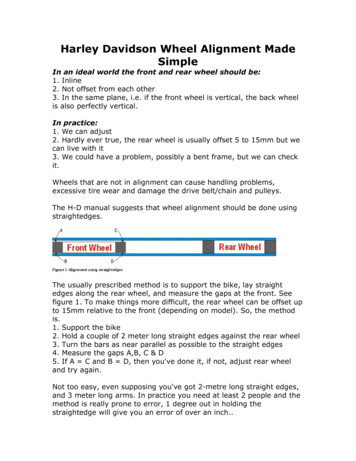
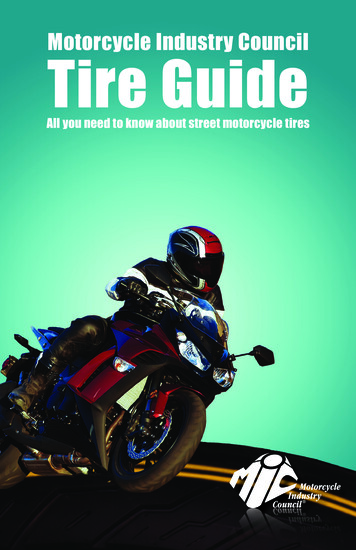
![Motorcycle Mechanic [MM] - CTEVT](/img/5/motorcycle-20-20mechanic-2010.jpg)
